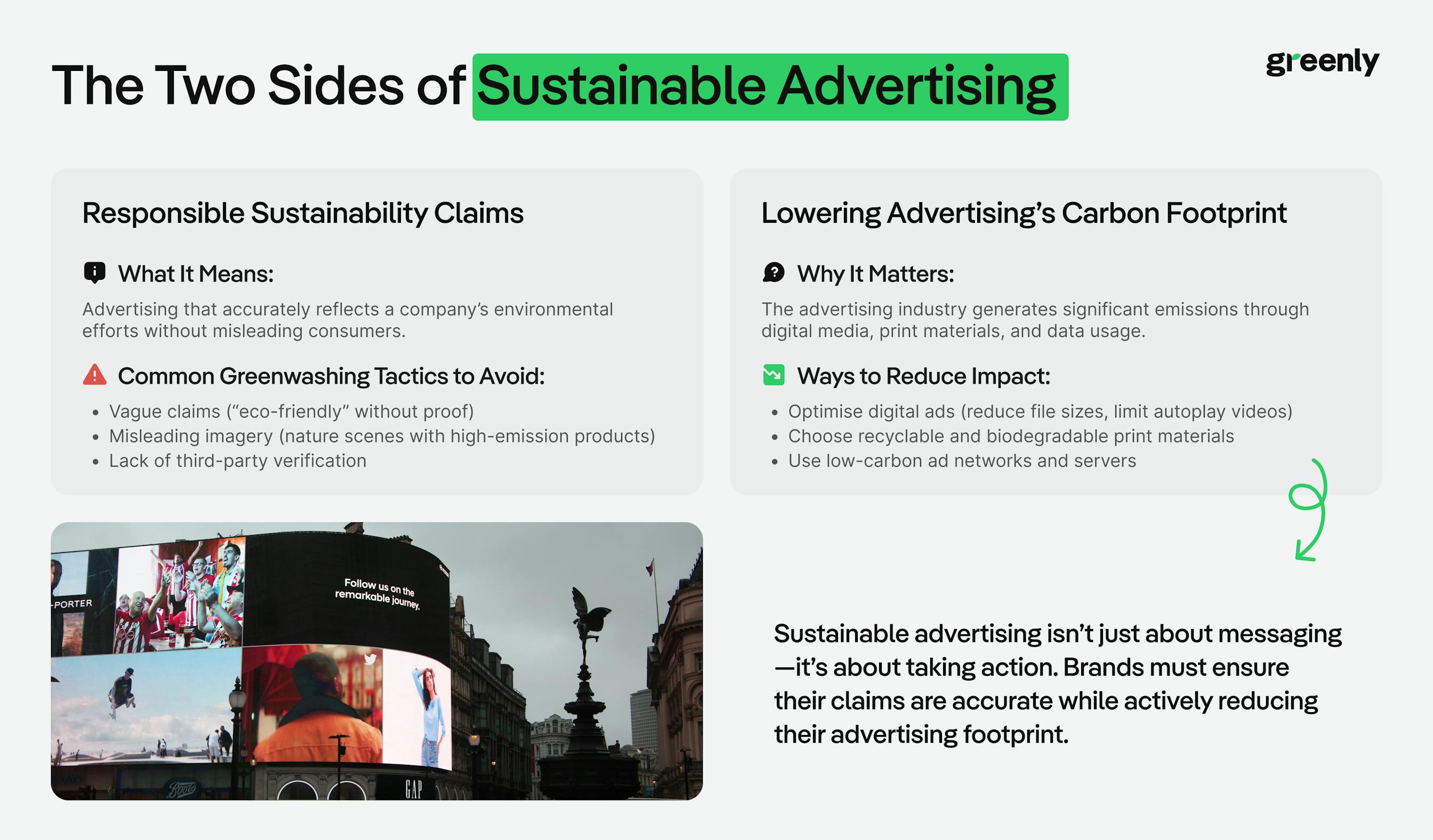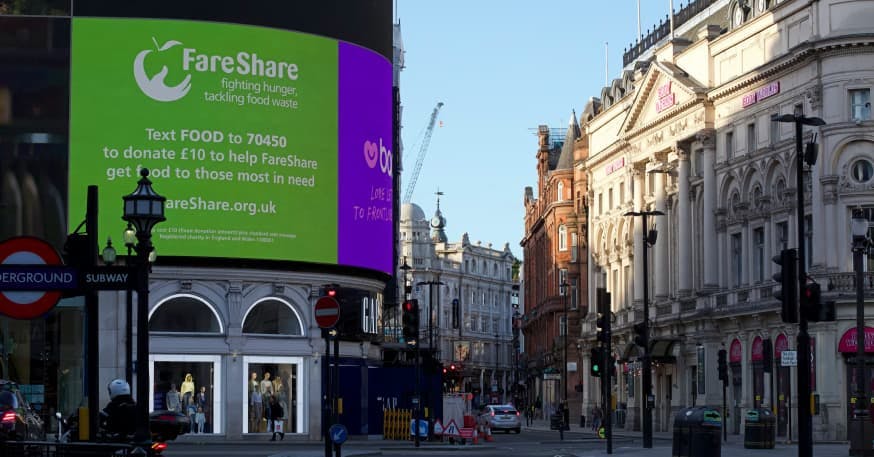ESG / CSR
Industries
Our guide to sustainable advertising



Advertising has the power to shape perceptions, influence consumer behavior, and drive business growth. But as sustainability becomes a defining issue for both consumers and regulators, brands face increasing pressure to ensure their advertising aligns with genuine environmental commitments. Enter sustainable advertising - a growing movement focused on promoting sustainability responsibly while minimizing the environmental impact of marketing efforts.
Getting it right is more than just an ethical choice; it’s a strategic one. The benefits of sustainable advertising go beyond brand reputation, helping businesses foster long-term consumer trust, stay ahead of regulatory scrutiny, and align with evolving market expectations. On the flip side, misleading green advertising - commonly known as greenwashing—can damage credibility, attract legal challenges, and alienate eco-conscious audiences.
At the heart of sustainability marketing is the need for transparency. With stricter regulations like the UK’s Green Claims Code and the US Federal Trade Commission (FTC) Green Guides, companies must ensure their environmental claims are backed by evidence and free from exaggeration. Meanwhile, brands looking to reduce the environmental footprint of their campaigns are exploring innovative ways to make advertising itself more sustainable - from cutting emissions in digital ad placements to using eco-friendly materials in print.
In this guide, we’ll explore how businesses can advertise sustainability responsibly, avoid common pitfalls, and implement sustainable marketing strategies that align with both consumer expectations and regulatory requirements.
What is sustainable advertising?
While often used interchangeably, sustainable advertising is a distinct concept from sustainable marketing. Sustainable marketing is a broader strategy that incorporates sustainability into all aspects of a company’s branding and consumer engagement.
In contrast, sustainable advertising focuses specifically on how companies communicate their sustainability efforts through promotional campaigns - ensuring the messaging is truthful and the advertising methods themselves align with environmental responsibility.
There are two main pillars of green advertising:
- Honest and transparent sustainability claims – As consumer awareness grows and regulations tighten, brands must ensure that their advertisements accurately reflect their environmental impact. Misleading terms like “eco-friendly” or “carbon neutral” without proper substantiation can lead to accusations of greenwashing, damaging brand trust and exposing businesses to legal risks.
- Reducing the environmental impact of advertising itself – Advertising contributes to carbon emissions, whether through the energy consumption of digital ads, the waste generated by print advertising, or the production of large-scale campaigns. Sustainable advertising involves using lower-carbon alternatives, optimizing digital campaigns to reduce energy use, and selecting eco-conscious advertising materials.
With regulators cracking down on greenwashing and consumers demanding more accountability, brands must approach sustainability advertising with a commitment to both ethical messaging and responsible execution. In the next section, we’ll explore how businesses can ensure their sustainability claims are credible and compliant with evolving regulations.


How to ensure sustainability claims are credible
As consumer demand for sustainability grows, so too does the scrutiny of green advertising. Companies that make environmental claims in their ads must ensure they are truthful, specific, and verifiable - or risk being accused of greenwashing. Misleading or exaggerated claims can damage a brand’s reputation, lead to regulatory action, and erode consumer trust.
What is Greenwashing?
Greenwashing occurs when a company overstates, misrepresents, or falsely implies that its products, services, or operations are more environmentally friendly than they actually are. This can take many forms, including:
- Vague or unsubstantiated claims – Phrases like “eco-friendly” or “sustainable” without clear evidence.
- Hidden trade-offs – Highlighting one green aspect of a product while ignoring other negative environmental impacts.
- False certifications – Using misleading labels or creating in-house “certifications” that lack third-party verification.
- Carbon neutrality claims based on offsets – Many brands claim to be "carbon neutral" through carbon offsetting rather than actual emissions reductions, a practice now facing increased regulatory scrutiny.
Several high-profile brands have faced backlash for misleading sustainability marketing. One of the most high-profile examples is BP (formerly British Petroleum). The company rebranded itself as “Beyond Petroleum” and emphasized its investments in renewable energy in advertising campaigns. However, a complaint filed by environmental group ClientEarth in 2019 highlighted that BP’s ads misrepresented its business model - more than 96% of the company’s annual spending was still on oil and gas. This kind of selective storytelling, where a company highlights minor sustainability initiatives while ignoring its larger environmental impact, is a common form of greenwashing.
How can you make sure your sustainability claims are credible?
To ensure transparency and avoid greenwashing, brands should follow these key principles:
1. Be transparent and specific
Consumers and regulators are demanding more clarity in sustainability claims. Instead of broad statements like “environmentally friendly”, use concrete, measurable claims such as:
- Made from 85% recycled materials
- Reduces emissions by 40% compared to our previous model
- Manufactured using 100% renewable energy
2. Provide evidence and verification
Regulators are increasingly requiring businesses to back up their claims with verifiable data. To ensure credibility:
- Use independent third-party certifications (eg. B Corp, Fair Trade, FSC-certified, CarbonNeutral).
- Publish lifecycle assessments (LCA) to quantify a product’s environmental impact.
- Link to reports or research that substantiate claims.
3. Stay aligned with regulations
In response to growing concerns over misleading sustainability advertising, regulatory bodies have introduced stricter guidelines:
- UK: The Advertising Standards Authority (ASA) and the Competition and Markets Authority (CMA) enforce the Green Claims Code, requiring environmental claims to be truthful, clear, and evidence-based.
- US: The Federal Trade Commission (FTC) Green Guides outline best practices for sustainability-related claims, warning against deceptive marketing tactics.
- EU: Regulations such as the Green Claims Directive and the Greenwashing Directive protect consumers by prohibiting vague claims like “climate neutral” unless backed by robust data.
Brands must ensure their advertising teams understand these regulations to avoid costly penalties and reputational damage.
4. Focus on progress, not perfection
No brand is 100% sustainable, and consumers recognize that. Instead of claiming to be “fully green”, brands should emphasize their sustainability journey:
- We’ve reduced our plastic packaging by 60% and aim for 100% by 2025.
- Our goal is to cut emissions by 50% by 2030 through renewable energy and supply chain optimization.
By acknowledging areas for improvement, brands can foster authenticity and consumer trust rather than overpromising.
| Region | Regulatory Authority | Key Regulations | Overview | Enforcement and Penalties |
|---|---|---|---|---|
| United Kingdom (UK) | Competition and Markets Authority (CMA), Advertising Standards Authority (ASA) | Green Claims Code, CAP and BCAP Codes | The Green Claims Code sets guidelines for making environmental claims, ensuring they are clear, truthful, and evidence-based. The CAP and BCAP Codes regulate non-broadcast and broadcast advertisements to prevent misleading sustainability claims. | The CMA can take enforcement action, including fines and corrective orders. The ASA can ban misleading ads and require changes to advertising materials. |
| United States (US) | Federal Trade Commission (FTC) | Green Guides | The FTC’s Green Guides provide businesses with guidance on making environmental claims, requiring them to be substantiated and non-deceptive. | The FTC can impose fines, issue cease-and-desist orders, and mandate corrective advertising for misleading sustainability claims. |
| European Union (EU) | European Commission, National Consumer Protection Authorities | Unfair Commercial Practices Directive, Green Claims Directive, Empowering Consumers for the Green Transition Directive | The Unfair Commercial Practices Directive prohibits misleading green claims. The Green Claims Directive (pending approval) will standardize substantiation of voluntary environmental claims. The Empowering Consumers for the Green Transition Directive bans generic terms like "eco-friendly" unless scientifically validated. | National authorities can impose fines, mandate corrective action, and ban misleading advertisements. The Green Claims Directive proposes harmonized enforcement across all EU member states. |

Reducing the environmental impact of advertising
While much of the focus on sustainable advertising is on ensuring truthful sustainability claims, another key aspect is minimizing the environmental footprint of advertising itself. The advertising industry has a surprisingly high carbon footprint, contributing to global emissions through energy-intensive digital infrastructure, resource-heavy production processes, and wasteful media placements.
From streaming video ads to billboard production, every stage of an advertising campaign has an environmental cost. Brands committed to sustainable marketing strategies must consider how their advertising operations can be optimized to reduce waste, energy use, and overall emissions.
How advertising contributes to carbon emissions
Digital advertising and data processing
- Online advertising relies on data centers, real-time bidding, and ad exchanges, all of which consume vast amounts of energy.
- A typical digital ad campaign can generate 5.4 metric tons of CO2, exceeding the average individual's annual carbon footprint.
- Programmatic advertising (where ads are automatically bought and placed through algorithms) requires multiple data transfers per second, leading to unnecessary energy waste.
Video and display ads
- Video ads are among the most energy-intensive forms of digital media. The longer and higher quality the video, the greater the emissions.
- Autoplay features and high-resolution formats increase energy consumption on both servers and user devices.
- Streaming ads on mobile networks emits less carbon dioxide than via Wi-Fi due to increased data transmission requirements.
Print and outdoor advertising
- Traditional print advertising consumes large amounts of paper, ink, and plastic-based materials, often with short lifespans.
- Billboards and signage contribute to plastic and electronic waste, particularly when non-recyclable materials are used.
- Illuminated billboards and screens in public spaces increase electricity consumption, particularly when powered by fossil fuels.
Ways to make advertising more sustainable
So how can companies make their advertising efforts more sustainable?
| Category | Sustainable Advertising Strategies |
|---|---|
| Optimizing Digital Advertising to Reduce Emissions | Reduce ad server requests by streamlining supply chains and using carbon-aware media buying. |
| Prioritize low-energy formats—static display ads, lightweight HTML banners, and compressed video files. | |
| Schedule campaigns to run when grid electricity demand is lower, reducing reliance on fossil-fuel power sources. | |
| Avoid excessive programmatic bidding, which results in multiple data transfers for the same ad impression. | |
| Reducing Video Advertising’s Carbon Footprint | Use lower-resolution video formats when possible (e.g., 720p instead of 1080p or 4K). |
| Limit autoplay ads, especially on mobile networks where streaming emissions are higher. | |
| Encourage shorter ad lengths—even reducing video duration by 5 seconds can significantly lower energy consumption. | |
| Eco-Friendly Print and Outdoor Advertising | Switch to recyclable and biodegradable materials for billboards and printed ads. |
| Use solar-powered billboards or LED lighting with energy-efficient settings. | |
| Reduce reliance on mass leaflet printing and prioritize QR codes or digital alternatives. | |
| Choosing Low-Carbon Ad Platforms | Work with advertising networks that use renewable energy for data centers and media delivery. |
| Exclude high-emission websites from ad placements—studies show that removing the top 20% most energy-intensive domains can reduce emissions by up to 60%. | |
| Use carbon calculators to measure the environmental impact of campaigns and optimize for sustainability. |
By integrating these measures, brands can ensure that green advertising is not just about messaging, but also about tangible efforts to reduce environmental harm.
Examples of brands leading the way in sustainable advertising
While many companies are still adapting to sustainable advertising, some brands have taken the lead in aligning their marketing efforts with environmental responsibility. Below, we highlight two standout green marketing examples that demonstrate how businesses can create impactful campaigns while maintaining authenticity.
Patagonia
Patagonia has built its brand around environmental activism, and its advertising strategy reflects this commitment. One of the most well-known green advertising campaigns was its “Don’t Buy This Jacket” campaign, which ran in The New York Times on Black Friday in 2011. Rather than encouraging consumption, the ad urged consumers to consider the environmental cost of purchasing new products unnecessarily.
By openly acknowledging the impact of manufacturing and promoting sustainable consumer behavior, Patagonia reinforced its brand ethos while gaining trust from eco-conscious audiences. This campaign also aligned with the company's repair and reuse initiatives, such as its Worn Wear program, which encourages customers to extend the lifespan of their gear instead of replacing it.
Unilever
Unilever has integrated sustainable marketing strategies into its advertising by incorporating carbon footprint transparency into its product labels and campaigns. The company is making efforts to display the life-cycle carbon impact on select products (over 70,000 of them), helping consumers make more informed purchasing decisions.
Unilever’s commitment extends to its brand portfolio, with products such as Dove, Persil, and Ben & Jerry’s highlighting their sustainability credentials in their marketing. This focus on measurable impact rather than vague environmental claims helps prevent greenwashing and fosters trust with consumers.
The future of sustainable advertising
As consumers become more environmentally conscious and regulations tighten, the advertising industry must evolve to meet higher standards of transparency and accountability. Brands can no longer rely on vague sustainability claims or flashy eco-friendly imagery - credibility, verifiable data, and measurable impact are now essential to building trust.
The future of sustainable advertising will be shaped by:
- Stricter regulations on green claims: With laws like the EU Green Claims Directive, the UK’s Green Claims Code, and the FTC Green Guides, brands must prove their sustainability claims or risk legal action.
- Carbon-optimised advertising: Brands will need to cut emissions from advertising by reducing energy-intensive formats, optimising ad delivery, and working with low-carbon ad networks.
- Sustainability as a competitive advantage: Companies that authentically integrate sustainability into their messaging will gain consumer trust. Green claims must be fact-based, consumer-focused, and third-party verified.
How Greenly can help your company
At Greenly, we help businesses take control of their carbon footprint by providing comprehensive carbon management solutions. From tracking emissions to implementing reduction strategies, we support companies in making genuine progress toward sustainability while ensuring compliance with evolving regulations.
- Carbon Footprint Assessment: Measure and analyze emissions across all scopes (1, 2, and 3) to understand environmental impact.
- Regulatory Compliance: Stay ahead of climate regulations, ensuring sustainability claims are accurate and verifiable.
- Emission Reduction Strategies: Develop tailored action plans to reduce carbon output across operations and supply chains.
- Supplier Sustainability Support: Identify and collaborate with low-carbon suppliers to make business practices more sustainable.
Greenly helps businesses reduce emissions, improve transparency, and align with global sustainability goals. Get in touch with us today to find out more.






